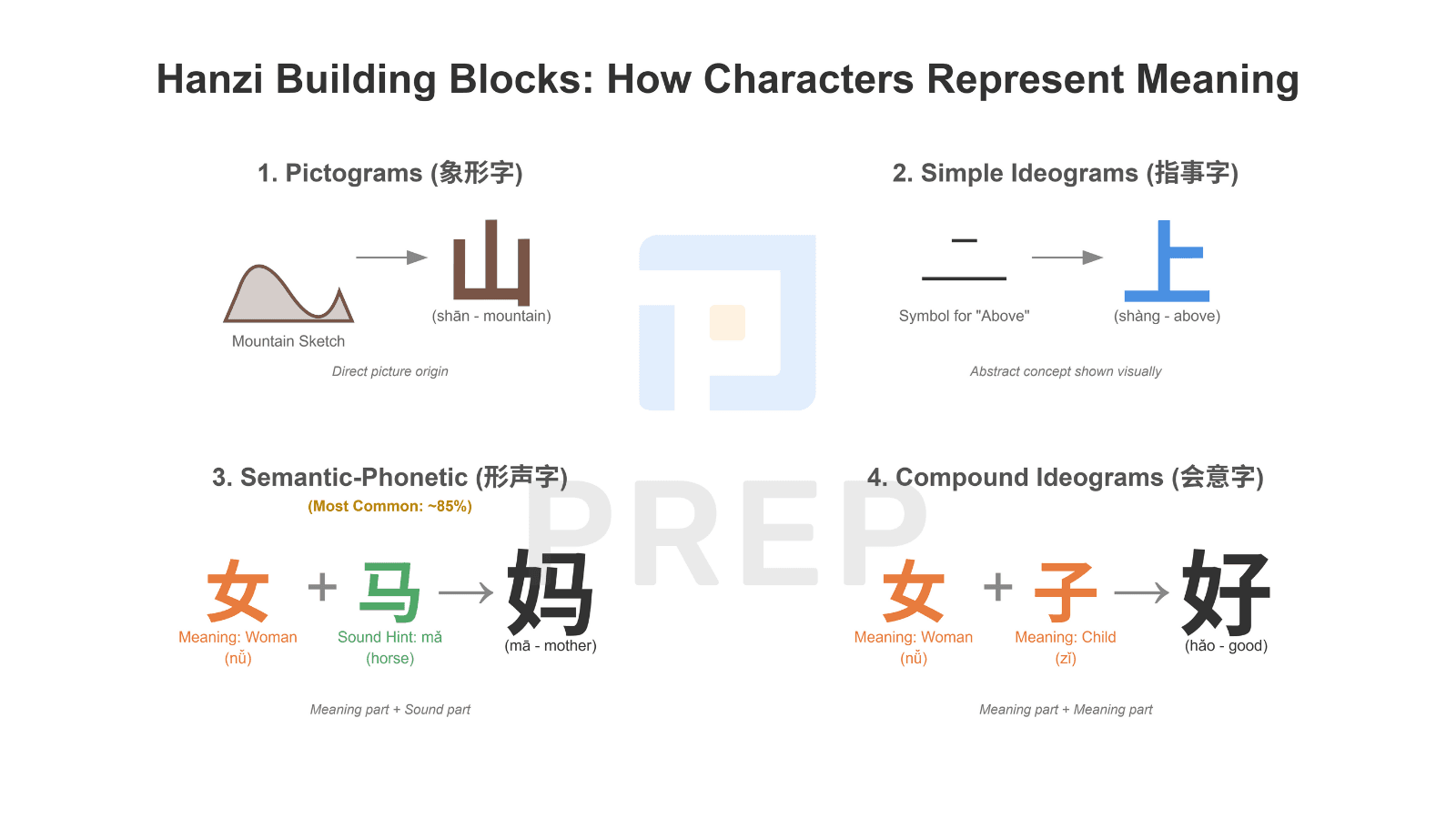Unlocking Chinese Ideograms: A Clear Guide to Hanzi Characters
Chinese ideograms are often misunderstood as purely pictorial symbols representing ideas, but they're actually part of a sophisticated logographic writing system called Hanzi (汉字). This comprehensive guide clarifies their true nature, explains how they're formed, and traces their evolution from ancient Chinese ideograms to the modern characters used today, helping you understand one of the world's oldest and most fascinating writing systems.
- I. Starting Point: Why "Ideograms" and What Are We Really Talking About?
- II. The Building Blocks: How Hanzi Represent Meaning
- III. Seeing the System: Hanzi vs. Alphabets
- IV. A Glimpse Through Time: The Evolution of Hanzi
- V. Supplemental Insights: Expanding Your Understanding of Hanzi
- VI. Beyond "Ideograms": Appreciating the Richness of Chinese Writing

I. Starting Point: Why "Ideograms" and What Are We Really Talking About?

1. Addressing the Common Term: "Chinese Ideograms"
When you search for information about Chinese writing, you likely encounter the term "Chinese ideograms." This terminology makes intuitive sense—these characters seem to represent ideas or concepts visually. The striking visual nature of these symbols naturally leads many to describe them this way. However, while understandable, this term isn't the most precise way to describe the entire Chinese writing system.
2. Introducing Hanzi (汉字): The Correct Term for Chinese Characters
The accurate native term for these characters is "Hanzi" (汉字, Hànzì), which simply means "Chinese characters." These characters form the writing system used for Chinese languages with origins dating back over 3,000 years. Hanzi represents one of the oldest continuously used writing systems in the world and carries immense cultural significance beyond mere communication.
3. From "Ideograms" to Logograms: A Crucial Clarification
Understanding the difference between ideograms and logograms is fundamental to grasping Chinese writing. An ideogram is a symbol that directly represents an idea or concept without necessarily connecting to spoken language. Examples include non-linguistic symbols like ♀ (female) or abstract Hanzi like 上 (up) and 下 (down).
A logogram, however, is a character that represents a word or meaningful morpheme in the language. The vast majority of Chinese characters fall into this category—they map to specific syllables and morphemes in spoken Chinese. While many characters began as pictorial representations, they evolved to represent specific words rather than abstract concepts alone.
Therefore, the Chinese writing system is most accurately described as logographic. This distinction is crucial because it helps explain how the characters function within the language system—not simply as pictures of ideas, but as written representations of the spoken language.
II. The Building Blocks: How Hanzi Represent Meaning

1. Visual Origins Part 1: Pictograms (象形字 xiàngxíngzì)
Pictograms are among the most straightforward Chinese characters, derived directly from pictures of objects they represent. Though highly stylized in modern form, their visual origins remain discernible. For example:
山 (shān) - mountain: The character resembles three peaks. 日 (rì) - sun: Depicts a sun with a central mark. 月 (yuè) - moon: Represents the crescent shape. 人 (rén) - person: Shows a walking human figure in profile. 木 (mù) - tree: Portrays a tree with branches and roots.
These characters show the direct pictorial relationship between form and meaning, though centuries of standardization have made these connections less obvious to modern eyes. Ancient Chinese ideograms often featured more explicit visual representations before evolving into their current forms.
2. Visual Origins Part 2: Simple Ideograms (指事字 zhǐshìzì)
Simple ideograms represent abstract concepts visually, often using symbolic indicators or modifying existing pictograms. These characters constitute a small but important subset of Hanzi. Examples include:
一 (yī) - one: A single horizontal stroke. 二 (èr) - two: Two horizontal strokes. 三 (sān) - three: Three horizontal strokes. 上 (shàng) - above: Shows a mark above a line. 下 (xià) - below: Shows a mark below a line.
These characters demonstrate how abstract ideas can be represented through visual logic, using simple indicators to convey position, quantity, or relative relationships. The direct visual connection to meaning makes these some of the purest examples of actual ideographic writing within the Chinese system.
3. The Most Common Type: Semantic-Phonetic Compounds (形声字 xíngshēngzì)
Semantic-phonetic compounds constitute approximately 80-90% of all Chinese characters, making them the dominant category by far. These characters combine two essential components:
-
A Semantic component (radical): Suggests the meaning or category of the character
-
A Phonetic component: Hints at the pronunciation
This brilliant innovation allowed Chinese writing to expand dramatically beyond simple pictorial representations. For example:
妈 (mā) "mother" =
-
女 (nǚ) "woman" [semantic component]: Indicates the character relates to females
-
马 (mǎ) "horse" [phonetic component]: Suggests the pronunciation (mā)
河 (hé) "river" =
-
氵(shuǐ) "water" [semantic component]: Shows the character relates to water
-
可 (kě) [phonetic component]: Suggests the pronunciation (hé)
It's important to note that the phonetic hint isn't always perfect in modern Mandarin due to language evolution over thousands of years. Pronunciations have shifted, while written forms remained relatively stable. Nevertheless, this structure remains fundamental to understanding how most Chinese characters are formed and organized.
4. Other Formation Methods (Briefly)
Beyond the major categories, several other formation methods exist. Compound ideograms (会意字 huìyìzì) combine existing characters based on meaning rather than pronunciation. For example, 好 (hǎo) "good" combines 女 "woman" and 子 "child." These categories originate from the traditional "Six Categories" (六书 Liùshū) classification system, which has organized Chinese character formation principles since the Han dynasty.
III. Seeing the System: Hanzi vs. Alphabets
1. Core Difference: Sound vs. Meaning Focus
The fundamental distinction between Chinese characters and alphabetic writing systems lies in what they primarily represent. Alphabets like Latin primarily represent sounds (phonemes), with letters combining to form words. Chinese characters, however, primarily represent meaningful units (morphemes/words), with sound often indicated secondarily.
This difference creates distinct reading experiences. Alphabetic readers decode sound first, then derive meaning. Hanzi readers often process meaning directly from character recognition, with sound as a secondary component. This explains why dictionaries of Chinese ideograms are organized primarily by visual components rather than phonetic elements as in alphabetic languages.
2. Implications for Learning and Use
This structural difference has significant practical consequences. Alphabetic readers need to learn a limited set of letters and rules to sound out virtually any word. Hanzi readers must learn thousands of individual characters, recognizing their components and understanding how they combine.
The major advantage of this system is that Hanzi unifies written communication across China's diverse linguistic landscape. Speakers of Mandarin, Cantonese, Shanghainese, and other Chinese languages may not understand each other's speech, but they can communicate through the same written characters, as the characters represent meaning rather than specific pronunciations. This helped maintain cultural and political unity throughout China's long history, demonstrating how ancient Chinese ideograms evolved into a sophisticated communication system.
IV. A Glimpse Through Time: The Evolution of Hanzi

1. From Oracle Bones to Modern Script
Chinese characters have undergone remarkable evolution over thousands of years. The earliest recognizable precursors appeared as Oracle Bone Script (甲骨文 jiǎgǔwén) during the Shang Dynasty (circa 1600-1046 BCE), inscribed on animal bones and turtle shells for divination purposes. Bronze inscriptions of the Zhou Dynasty (1046-256 BCE) showed greater regularization.
The Qin Dynasty unification (221-206 BCE) brought standardization through Small Seal Script (小篆 xiǎozhuàn). The Han Dynasty (206 BCE-220 CE) saw a pivotal transformation with Clerical Script (隶书 lìshū), which moved toward more angular, efficient forms. This eventually evolved into Standard Script (楷书 kǎishū), which forms the basis of modern printed characters. Throughout this evolution, the general trend has been toward greater regularization and simplification of forms.
2. Simplified vs. Traditional Characters
The 20th century brought the most recent major evolution with China's character simplification movement. Simplified Characters (简体字 jiǎntǐzì) were officially adopted in Mainland China in the 1950s to increase literacy rates by reducing stroke counts and standardizing forms. Traditional Characters (繁體字 fántǐzì) preserved the older forms.
Today, Simplified Characters are used in Mainland China and Singapore, while Traditional Characters persist in Taiwan, Hong Kong, Macau, and many overseas Chinese communities. It's worth noting that many characters are identical in both systems, and the core principles of character formation remain the same regardless of which set is used.
Now that we've covered the fundamentals of what Hanzi are, how they're formed, and their history, let's address some common questions to provide further clarity and context.
V. Supplemental Insights: Expanding Your Understanding of Hanzi
1. What exactly is a "radical" in Chinese characters?
A radical (部首 bùshǒu) is a character component that serves as the primary classifier in the Chinese writing system. Radicals typically provide semantic information, hinting at the character's meaning field. They also serve as organizational tools in dictionaries, allowing users to look up characters by their component parts. Traditional dictionaries organized characters under 214 Kangxi radicals, though modern systems may use fewer. For example, the 'water' radical 氵appears in characters like 河 (hé, "river") and 海 (hǎi, "sea"), indicating their relationship to water.
2. How do Simplified Chinese characters differ from Traditional ones?
Simplified Characters were developed to promote literacy through reduced complexity. The simplification process employed several methods: reducing stroke counts (e.g., 龙 for 龍 "dragon"), merging characters with similar pronunciations, standardizing cursive forms into regular script, and substituting simplified components consistently across multiple characters. While the geographic usage differs as mentioned earlier, it's important to understand that this isn't a completely different writing system—many characters remain unchanged, and the underlying structural principles are identical.
3. Are all Chinese characters ideograms or pictograms?
No. While pictograms and ideograms represent important origins and types of Chinese characters, they constitute a minority of the total character inventory. The overwhelming majority (80-90%) are semantic-phonetic compounds that combine meaning and sound components. This is why "logographic" is a more accurate description of the overall system, as most characters represent specific words or morphemes rather than abstract ideas alone.
4. What other writing systems use characters derived from Hanzi?
Chinese characters have influenced several East Asian writing systems. Japanese Kanji are Chinese characters adapted to write Japanese, still widely used alongside the syllabic Hiragana and Katakana scripts. Korean Hanja are Chinese characters historically used for Korean, though their modern use is limited since the adoption of the Hangul alphabet. Vietnamese Chữ Nôm was a character system based on Chinese principles used to write Vietnamese before the current Latin-based script was adopted. Each system adapted Chinese characters to fit the phonology and grammar of these distinct languages.
VI. Beyond "Ideograms": Appreciating the Richness of Chinese Writing
1. Hanzi as More Than Just Writing
Chinese characters transcend their role as mere writing tools. They form the foundation of Chinese calligraphy, one of the most esteemed traditional art forms. Through different styles—from meticulous regular script to flowing cursive—calligraphy expresses aesthetic values, philosophical principles, and personal character. Hanzi connect modern Chinese speakers to thousands of years of literature, poetry, and wisdom. Many learners find intellectual satisfaction in discovering the internal logic of characters, tracing their evolution, and understanding how components create meaning—a satisfaction that transcends mere memorization.
2. Final Thoughts: From Misconception to Clarity
Our journey began with the common term "Chinese ideograms," which we've now clarified as more accurately described by "logograms." We've explored how these characters work—from the visually direct pictograms and ideograms to the ingenious semantic-phonetic compounds that comprise most of the system. We've seen how they evolved over millennia and how they compare to other writing systems.
Understanding Hanzi goes beyond terminology. It reveals a sophisticated system that has successfully communicated meaning for thousands of years. While the initial complexity may seem daunting to learners, recognizing the structural patterns and historical evolution helps unlock this remarkable writing system. Far from being mysterious symbols, Chinese characters reveal themselves as a logical, sophisticated writing system that continues to serve as a foundation for one of the world's oldest continuous civilizations.

Hi I'm Chloe, and I am currently serving as an Product Content Administrator at Prep Education. With over five years of experience in independent online IELTS study and exam preparation, I am confident in my ability to support learners in achieving their highest possible scores.
Comment
Premium content
View allPersonalized roadmap
Most read












